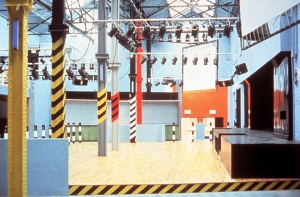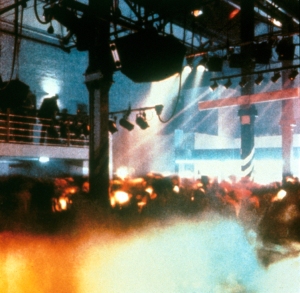A Letter from the Haçienda to Space Electronic
Ben Kelly
Ettore Sottsass, Superstudio, Archizoom Associati – these were all influences for me during the late 60’s and early 70’s. I guess these influences all fed into my thoughts about what the design of The Haçienda could be:
A journey through an industrial landscape boosted by theatre and technology. Visual puns to break your journey. A line of steel columns colour coded to warn you; take care, you never know who you might bump into on the disco floor…Cats’ eyes to stare at you with bollards to protect you. Monolithic slabs support the balcony, marching in line, speak a narrative of perforations. An angled arch with attendant monoliths to greet your ceremony, to be met by another in a state of decay. All wrapped in a coat of Pigeon Blue BS409. We are leaving the twentieth century.
(Catherine McDermott, Plans and Elevations (London: Architecture Design and Technology, 1990)

Interior of the Haçienda nightclub, a former Yacht showroom, designed by Ben Kelly in 1982. Image: Ben Kelly Design
The Italian architect and theorist Vittorio Gregotti described the inherent meaning found within a remodeled building as an uncovering of the truth:
Modification tells us that each specific situation offers a specific truth, to be sought and revealed as the essence of the goal, and as the truth of both the site and the geography that embodies that site’s particular history.
(Gregotti, Inside Architecture (Cambridge, Mass.; London: MIT Press, 1996).

Inside the Haçienda nightclub in the 1980s. Image: Ben Kelly Design
The Haçienda’s namecame from the Situationists. It revealed a shared ambition to transform the present through a disruptive unity of the arts.
And you, forgotten, your memories ravaged by all the consternations of two hemispheres, stranded in the Red Cellars of Pali-Kao, without music and without geography, no longer setting out for the haçienda where the roots think of the child and where the wine is finished off with fables from an old almanac. Now that’s finished. You’ll never see the haçienda, it doesn’t exist.
The haçienda must be built.
(Ivan Chtcheglov (1953) in Chris Gray, Leaving the Twentieth Century: The Incomplete Work of the Situationist International (London: Freefall Publications, 1974).
In 1982 Ben Kelly designed Manchester’s Haçienda night club. In the process he helped transform the face of clubbing, nightclubs and interior design in 1980s Britain. Today he runs Ben Kelly Design with Design Director Patrick McKinney and together they designed the Space Electronic installation.
References
Gray, Chris, Leaving the Twentieth Century: The Incomplete Work of the Situationist International (London: Freefall Publications, 1974)
Gregotti, Vittorio, Inside Architecture (Cambridge, Mass.; London: MIT Press, 1996)
McDermott, Catherine, Plans and Elevations (London: Architecture Design and Technology, 1990)